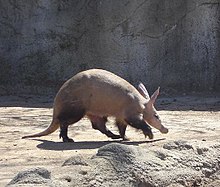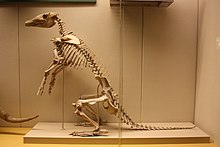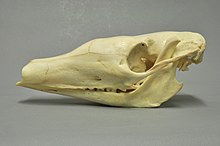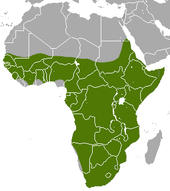Aardvark
The aardvark (Orycteropus afer) is a species of mammal and represents the sole recent representative of the genus Orycteropus in the family Orycteropodidae and the order Tubulidentata (tube teeth). Within the systematics of today's higher mammals, the tubular dentates are thus the only order that contains only one species.
Outwardly striking are the strong body of the aardvark with arched back and muscular legs as well as the tubular elongated snout and the fleshy tail. The species' range includes all of sub-Saharan Africa. The animals inhabit open and closed landscapes. They live solitary lives, are nocturnal, and burrow in the soil, making observation difficult overall. The lifestyle of the aardvark is therefore poorly studied. Its diet consists of state-forming insects, which is a highly specialized adaptation. The distinctive behaviour leads to the fact that loose soils and a sufficient amount of ants and termites are basic requirements for the presence of the aardvark in a certain region.
The relationships of the aardvark to other groups of higher mammals were unclear for a long time. Initially, the species was placed in a common taxon called Edentata, together with the similarly living pangolins, the anteaters and the armadillos, due to their specialized feeding habits. However, the similarities of the individual representatives are largely based on convergent evolution, not relatedness. Later, numerous researchers favored a closer relationship to the ungulates. It was not until molecular genetic studies at the end of the 20th century that the aardvark actually formed a kinship group with original African animals. The results of these investigations also suggest that the aardvark split off from the other lineages of this kinship group at an early stage in its phylogeny. Fossil finds are generally rare and at present reflect only the last 20 million years of evolutionary history. Within this period, however, relatives of the aardvark also reached present-day Europe and Asia, where they are now extinct again. The only recent representative is considered to be endangered.
Features
Habitus
The aardvark is a medium-sized to large representative of the mammals. It generally reaches a head-torso length of 94 to 142 cm and a shoulder height of 60 to 65 cm, the tail measures 44 to 63 cm. Weight ranges from 40 to 65 kg, but since the onset of sexual maturity in animals in the wild is unknown, variations are difficult to determine. A conspicuous sexual dimorphism is not developed. A total length of 149 to 175 cm and a tail length of 44.3 to 63.0 cm were recorded in 31 animals examined from Zimbabwe. The corresponding measurements in 10 animals from the Democratic Republic of Congo were 161 to 185 cm and 58 to 72 cm, respectively. Overall, the aardvark represents a compactly built animal that has a strong body with a prominent arched back, a relatively small head and a long, fleshy tail. The dorsal coat is relatively short with a hair length of about 1.8 cm, the covering sparse and interspersed with partly bald patches. It shows a grey-brown basic colouration, which can be overprinted by locally prevailing ground conditions. On the sides of the body and on the legs the body hair becomes denser and longer, the hairs here reach about 4 cm in length. The neck of the aardvark is short and broad. The head is characterized by an elongated shape, whose most striking feature is the tubular elongated snout. This ends in a soft, flexible nose and a small mouth opening. Bristle-like hairs are developed on the nostrils, most of which appear slit-shaped but can be opened wide and closed completely. The ears have an elongated shape reminiscent of rabbits and grow to between 15.8 and 21.0 cm in length. They are also extremely mobile. The eyes are located on the side of the head, are relatively small and have a brownish iris. Both above and below the eyes, and beyond them on the chin, are numerous bristly vibrissae. The legs are short and extremely strong. The front feet have four, the hind feet five rays, each ending in massive claws, the front ones being more developed than the hind ones. The individual toes are joined by small cuticles, which are useful for digging. The length of the hind foot is 22.5 to 29.0 cm. Females have two pairs of teats located in the thoracic and ventral regions. Both sexes have glands in the genital area.
Skull and dentition characteristics
The skull of the aardvark is between 24.0 and 25.5 cm long and 9.4 to 9.8 cm wide. Due to its rather elongated shape, it appears tubular. Similar to other highly specialized insectivores such as anteaters and pangolins, it lacks distinctive bone elevations or roughening, for example in the form of a parietal crest as muscle attachment points. Unlike the other two representatives, however, the aardvark has a closed, albeit slender, zygomatic arch. The maxilla, premaxillae and nasal bone are well developed and form an elongated rostrum. The nasal bone has a triangular design with the tip pointing forward and the posterior part widening; however, the paired bone is never fused. The frontal bone shows a characteristic bulge, which is caused by the extraordinarily developed olfactory bulb; as a result, the nasal interior also has a relatively large volume. The parietal bone is mostly completely fused, it is connected in the anterior region with the wing process of the sphenoid bone, so that the frontal bone and the temporal bone have no contact with each other. The palatine bone is long narrow, the laterally ascending portion forming part of the margin of the orbit. There are prominent openings in the posterior part of the palatine bone. The middle ear has a simple structure, a tympanic bladder is not formed.
The overall slender lower jaw widens in the area of the molars. The symphysis is rarely fused in today's aardvarks. At its posterior end is the mental foramen. The ascending branch rises high, with the crown process (processus coronoideus) higher than the articular process (processus condylaris). The mandibular joint is flat or slightly depressed. As a result, the articular fossa at the temporal bone, where the mandible locks in place, also has a rather weakly developed or arched design. The dentition of adult animals has a heterodont and reduced structure consisting of premolars and molars with, however, individually varying numbers of teeth. The dental formula is: 
Body skeleton
The spine is composed of 7 cervical, 13 thoracic, 8 lumbar, 6 sacral, and 25 to 28 caudal vertebrae. In non-adult animals and some extinct forms, only 5 sacral vertebrae occur. The locomotor system shows distinct adaptations to a burrowing lifestyle. Thus a clavicle of strong and strongly curved shape is developed. On the long bones of the arms and legs there are numerous raised groins as muscle attachment points and additionally broad joints. The shafts of the long bones consist for the most part of the compacted bone tubercles (trabeculae) of the bone interior (substantia spongiosa), while the outer bone envelope is largely resorbed. This particular bone structure, which differs from that of other large mammals, is explained by the strong adaptation to burrowing activities in conjunction with sometimes extreme external environmental conditions and thus limited food supply. On the foreleg, the humerus is equipped with an extremely massive lower (distal) joint, the width of which reaches over 35% of the length of the total bone. A strong bony ridge, the deltopectoral groin, also occurs on the shaft. A massive superior (proximal) articular process, the olecranon, is formed on the ulna, and the radius shows marked shortening and conspicuous bony ridges on the shaft. The pelvis also has a massive structure and is also elongated towards the back as well as the tail. The sacrum has no connection to the ischium, and the symphysis of the pubis is scarcely reduced in length compared with other burrowing mammals. The femur is short and robust, as well as furnished with a strong third rolling mound (trochanter tertius), which rises at the shaft above a prominent rib. On the lower leg, the tibia and fibula are fused together at the upper end of the joint, and the shaft of the tibia is also curved. The carpal and tarsal bones are characterized by a serial (taxeopod) arrangement, which is also prevalent in proboscideans and sloths. On the hand, the Os centrale is fused with the Os scaphoideum (navicular bone), on the foot, the talus does not articulate with the cuboid bone.
Soft Tissue Anatomy
The stomach of the aardvark corresponds to the simple construction plan of the mammals and is about 15 cm long with a diameter of 7.3 cm. It consists of two equal sacks, which are separated by a constriction. As a special feature, however, an extremely strong, ring-like musculature of about 2 cm thickness is formed in the rear section in the area of the stomach outlet (pylorus). This takes over the comminution of the food, which is otherwise mainly done by chewing. Another striking feature is the appendix, which is unusually large for insectivores. On the brain, the extremely enlarged olfactory bulb stands out, which is one of the largest within the higher mammals and thus also indicates the dominance of the sense of smell. Externally, the enlargement of the olfactory brain causes the forehead to bulge more. The eyes represent adaptations to darkness, cones are not developed, so that color vision is not possible. The cornea has a keratin layer on the outside as protection against insect bites. The strap-shaped tongue is long, warty and always moist and sticky due to abundant saliva secretion. It can be extended 25 to 30 cm out of the mouth and ends in a point. The nose consists of only two muscles. These are fleshy and do not form tendons. This means that the nose can only be moved to a limited extent.

Aardvark

Skeleton of an aardvark (in the Brussels Museum of Natural History)

Skull of an aardvark (Collection Museum Wiesbaden)
Distribution and habitat
The aardvark is endemic to Africa, where it is distributed over the entire continent south of the Sahara. It has not yet been recorded in Lesotho, but is most likely present there as well. It is sometimes assumed that the species does not occur in the Congo Basin, but there are numerous observations from there, for example from the Ituri forest in the Democratic Republic of Congo. The distribution in West Africa is poorly studied. Due to its wide range, the aardvark lives in very different habitats. It has been recorded mainly from open landscapes such as savannahs, bush and grasslands up to the semi-desert Karoo, but also from transitional regions from open to closed landscapes as well as from dense forests. However, the animals avoid extremely dry deserts and swampy regions. In eastern Africa, the species is also found in higher mountainous areas, such as the Udzungwa Mountains in Tanzania or the Bale Mountains in Ethiopia, where it has been sighted at altitudes of up to 3200 metres. The aardvark is bound to loose soils and prefers flat plains or gentle slopes that allow it to build burrows. It is therefore rarely found in stony or rocky terrain. Basically, the presence of ants and termites is a prerequisite for the presence of the aardvark, accessible water sources play only a minor role. The population density is rather low, in habitats favourable for the animals it is about 10 individuals per 10 km².
In the geological past from the Middle Miocene onwards, relatives of today's aardvark from the genus Amphiorycteropus, such as A. depereti and A. gaudryi, also colonized Eurasia. Here, however, they died out again at the beginning of the Pliocene and long before the arrival of man. Representations on vessels and in tombs suggest that the aardvark was also found in the Middle and Lower Nile Valley in Predynastic and Ancient Egypt.

Distribution area of the aardvark
Questions and Answers
Q: What is an aardvark?
A: An aardvark is a mammal that comes from Africa.
Q: What does the name "aardvark" mean?
A: The name "aardvark" means "earth pig" in Afrikaans.
Q: Is the aardvark the only living member in its order?
A: Yes, the aardvark is the only living member in its order.
Q: Have any fossil genera of the aardvark been found?
A: Yes, some fossil genera of the aardvark have been found.
Q: Where did the aardvark originate?
A: The aardvark originated in Africa.
Q: What language is the name "aardvark" from?
A: The name "aardvark" is from the language Afrikaans.
Q: What does the aardvark look like?
A: There is no information given in the text about what the aardvark looks like.
Search within the encyclopedia